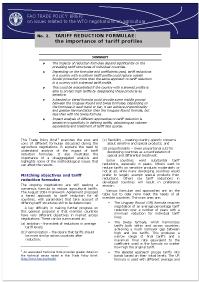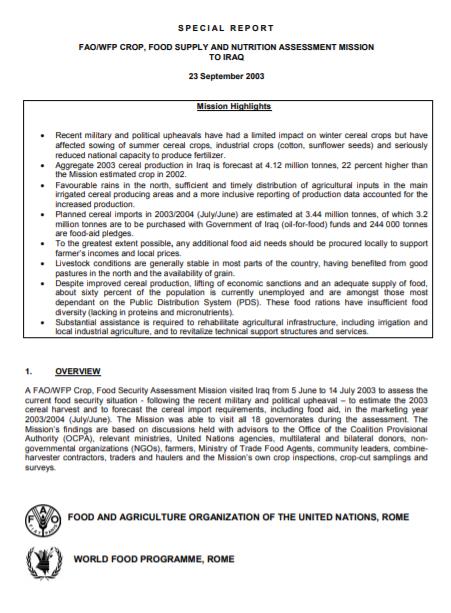
Special Report - FAO/WFP Crop, Food Supply and Nutrition Assessment Mission to Iraq
23/09/2003
A FAO/WFP Crop, Food Security Assessment Mission visited Iraq from 5 June to 14 July 2003 to assess the current food security situation - following the recent military and political upheaval – to estimate the 2003 cereal harvest and to forecast the cereal import requirements, including food aid, in the marketing year 2003/2004 (July/June). The Mission was able to visit all 18 governorates during the assessment. The Mission’s findings are based on discussions held with advisors to the Office of the Coalition Provisional Authority (OCPA), relevant ministries, United Nations agencies, multilateral and bilateral donors, nongovernmental organizations (NGOs), farmers, Ministry of Trade Food Agents, community leaders, combineharvester contractors, traders and haulers and the Mission’s own crop inspections, crop-cut samplings and surveys.
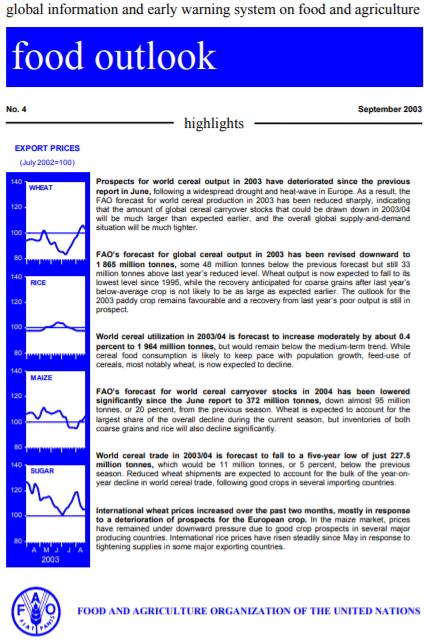
Food Outlook - September 2003
05/09/2003
Prospects for world cereal output in 2003 have deteriorated since the previous report in June, following a widespread drought and heat-wave in Europe. As a result, the FAO forecast for world cereal production in 2003 has been reduced sharply, indicating that the amount of global cereal carryover stocks that could be drawn down in 2003/04 will be much larger than expected earlier, and the overall global supply-and-demand situation will be much tighter. FAO’s forecast for global cereal output in 2003 has been revised downward to 1 865 million tonnes, some 48 million tonnes below the previous forecast but still 33 million tonnes above last year’s reduced level. Wheat output is now expected to fall to its lowest level since 1995, while the recovery anticipated for coarse grains after last year’s below-average crop is not likely to be as large as expected earlier. The outlook for the 2003 paddy crop remains favourable and a recovery from last year’s poor output is still in prospect. World cereal utilization in 2003/04 is forecast to increase moderately by about 0.4 percent to 1 964 million tonnes, but would remain below the medium-term trend. While cereal food consumption is likely to keep pace with population growth, feed-use of cereals, most notably wheat, is now expected to decline. FAO’s forecast for world cereal carryover stocks in 2004 has been lowered significantly since the June report to 372 million tonnes, down almost 95 million tonnes, or 20 percent, from the previous season. Wheat is expected to account for the largest share of the overall decline during the current season, but inventories of both coarse grains and rice will also decline significantly. World cereal trade in 2003/04 is forecast to fall to a five-year low of just 227.5 million tonnes, which would be 11 million tonnes, or 5 percent, below the previous season. Reduced wheat shipments are expected to account for the bulk of the year-onyear decline in world cereal trade, following good crops in several importing countries. International wheat prices increased over the past two months, mostly in response to a deterioration of prospects for the European crop. In the maize market, prices have remained under downward pressure due to good crop prospects in several major producing countries. International rice prices have risen steadily since May in response to tightening supplies in some major exporting countries.
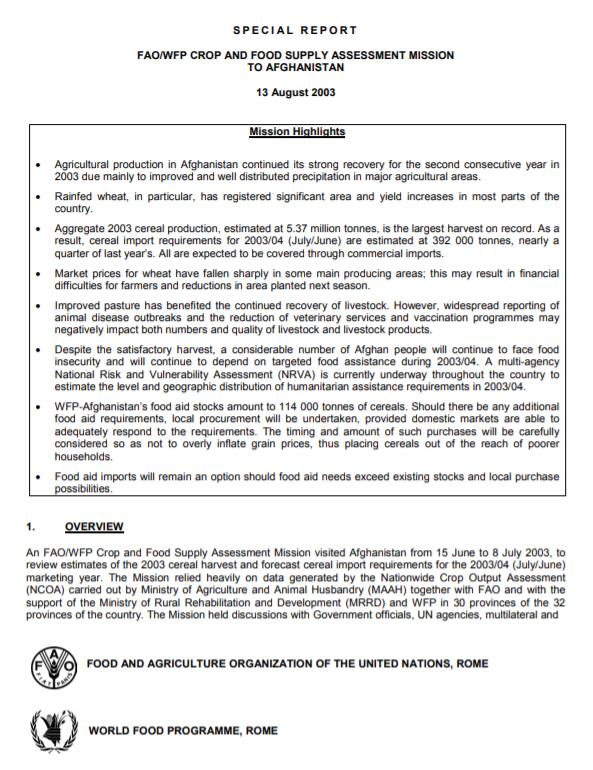
Special Report - FAO/WFP Crop and Food Supply Assessment Mission to Afghanistan - 13 August 2003
13/08/2003
An FAO/WFP Crop and Food Supply Assessment Mission visited Afghanistan from 15 June to 8 July 2003, to review estimates of the 2003 cereal harvest and forecast cereal import requirements for the 2003/04 (July/June) marketing year. The Mission relied heavily on data generated by the Nationwide Crop Output Assessment (NCOA) carried out by Ministry of Agriculture and Animal Husbandry (MAAH) together with FAO and with the support of the Ministry of Rural Rehabilitation and Development (MRRD) and WFP in 30 provinces of the 32 provinces of the country. The Mission held discussions with Government officials, UN agencies, multilateral and bilateral donors, local and international NGOs and made field visits to major crop producing northern and western provinces that allowed for some minor adjustments to NCOA data. The Mission also benefited from the United States Geological Survey (USGS) expertise in agro-meteorology. Available relevant reports and documents were reviewed and satellite based normalised difference vegetation indices (NDVI) and Snow Depletion Curves were analyzed.
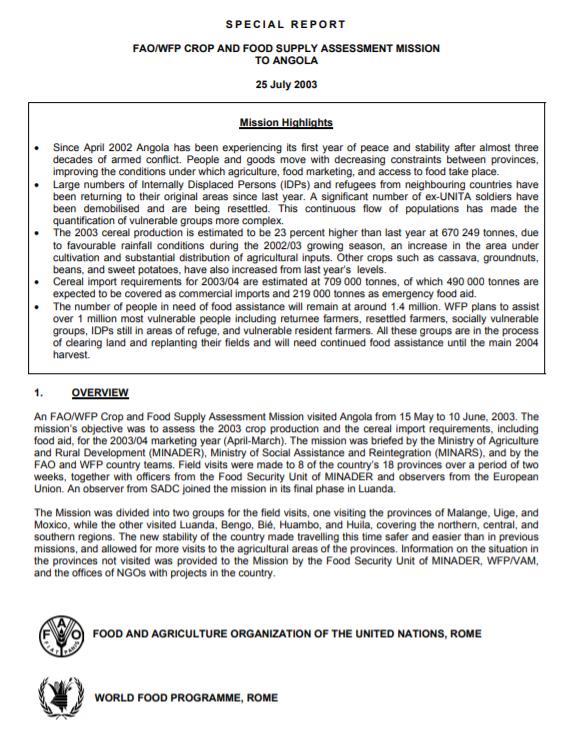
Special Report - FAO/WFP Crop and Food Supply Assessment Mission to Angola - 25 July 2003
25/07/2003
An FAO/WFP Crop and Food Supply Assessment Mission visited Angola from 15 May to 10 June, 2003. The mission’s objective was to assess the 2003 crop production and the cereal import requirements, including food aid, for the 2003/04 marketing year (April-March). The mission was briefed by the Ministry of Agriculture and Rural Development (MINADER), Ministry of Social Assistance and Reintegration (MINARS), and by the FAO and WFP country teams. Field visits were made to 8 of the country’s 18 provinces over a period of two weeks, together with officers from the Food Security Unit of MINADER and observers from the European Union. An observer from SADC joined the mission in its final phase in Luanda.
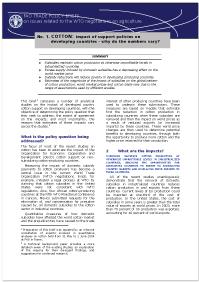
No. 1 Cotton: impact of support policies on developing countries - why do the numbers vary?
15/07/2003
Subsidies maintain cotton production at otherwise unprofitable levels in industrialized countries Excess supply induced by domestic subsidies has a depressing effect on the world market price Subsidy reductions will reduce poverty in developing producing countries Estimates of the magnitude of the impact of subsidies on the global pattern of cotton production, world market prices and cotton trade vary due to the range of assumptions used by different studies
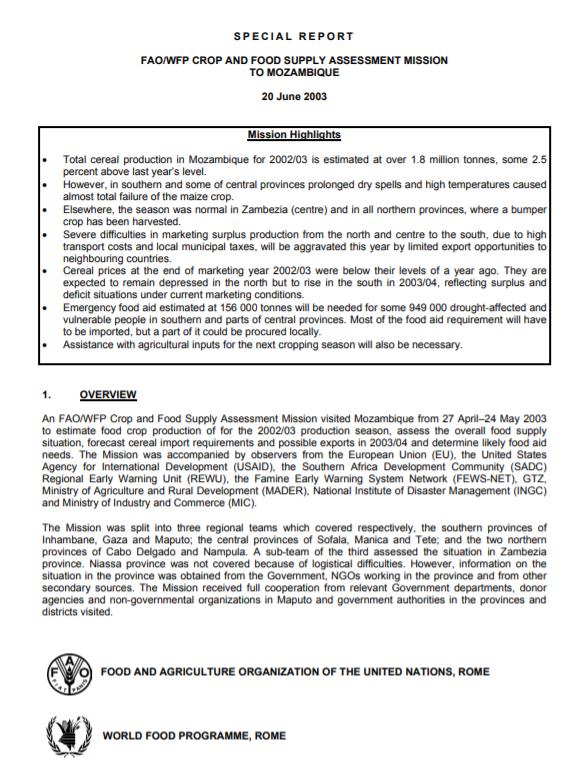
Special Report - FAO/WFP Crop and Food Supply Assessment Mission to Mozambique - 20 June 2003
20/06/2003
An FAO/WFP Crop and Food Supply Assessment Mission visited Mozambique from 27 April–24 May 2003 to estimate food crop production of for the 2002/03 production season, assess the overall food supply situation, forecast cereal import requirements and possible exports in 2003/04 and determine likely food aid needs. The Mission was accompanied by observers from the European Union (EU), the United States Agency for International Development (USAID), the Southern Africa Development Community (SADC) Regional Early Warning Unit (REWU), the Famine Early Warning System Network (FEWS-NET), GTZ, Ministry of Agriculture and Rural Development (MADER), National Institute of Disaster Management (INGC) and Ministry of Industry and Commerce (MIC).
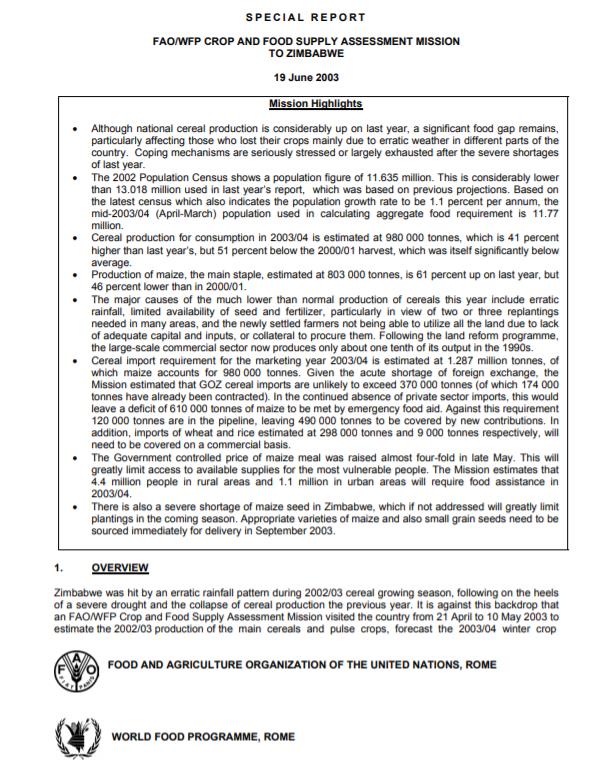
Special Report - FAO/WFP Crop and Food Supply Assessment Mission to Zimbabwe - 19 June 2003
19/06/2003
Zimbabwe was hit by an erratic rainfall pattern during 2002/03 cereal growing season, following on the heels of a severe drought and the collapse of cereal production the previous year. It is against this backdrop that an FAO/WFP Crop and Food Supply Assessment Mission visited the country from 21 April to 10 May 2003 to estimate the 2002/03 production of the main cereals and pulse crops, forecast the 2003/04 winter crop production, review the overall food situation and determine the food import requirement, including food assistance needs, for the next 12 months.
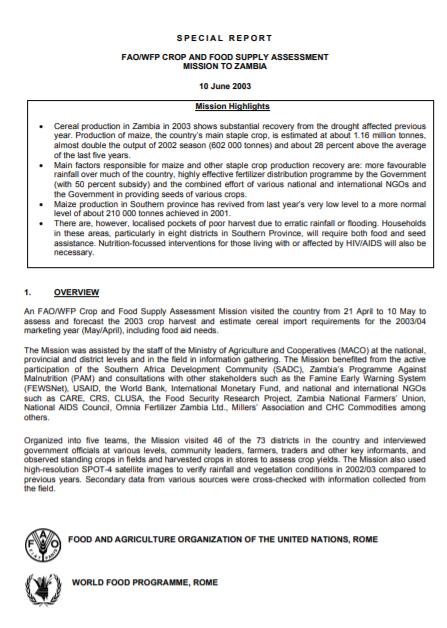
Special Report - FAO/WFP Crop and Food Supply Assessment Mission to Zambia - 10 June 2003
10/06/2003
An FAO/WFP Crop and Food Supply Assessment Mission visited the country from 21 April to 10 May to assess and forecast the 2003 crop harvest and estimate cereal import requirements for the 2003/04 marketing year (May/April), including food aid needs.
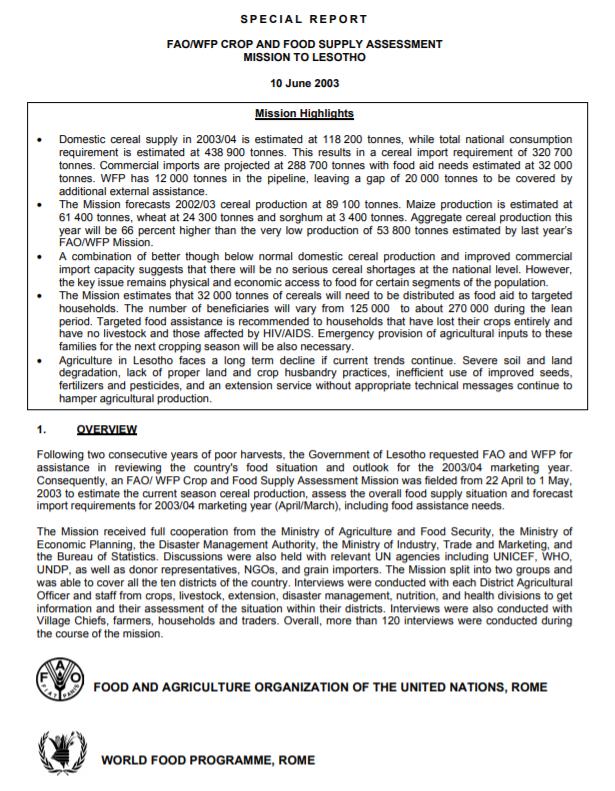
Special Report FAO/WFP Crop and Food Supply Assessment Mission to Lesotho
10/06/2003
Following two consecutive years of poor harvests, the Government of Lesotho requested FAO and WFP for assistance in reviewing the country's food situation and outlook for the 2003/04 marketing year. Consequently, an FAO/ WFP Crop and Food Supply Assessment Mission was fielded from 22 April to 1 May, 2003 to estimate the current season cereal production, assess the overall food supply situation and forecast import requirements for 2003/04 marketing year (April/March), including food assistance needs.
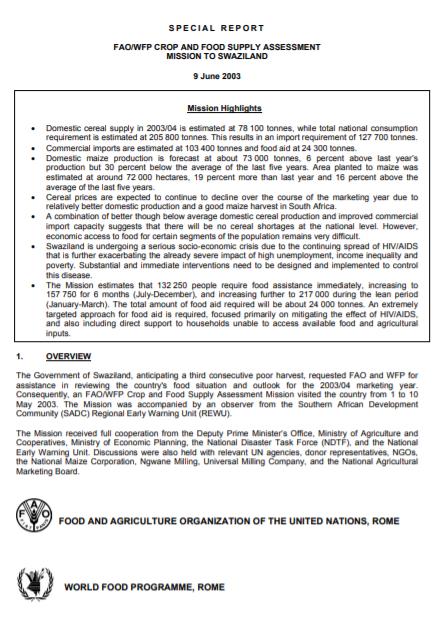
Special Report - FAO/WFP Crop and Food Supply Assessment Mission to Swaziland - 9 June 2003
09/06/2003
The Government of Swaziland, anticipating a third consecutive poor harvest, requested FAO and WFP for assistance in reviewing the country's food situation and outlook for the 2003/04 marketing year. Consequently, an FAO/WFP Crop and Food Supply Assessment Mission visited the country from 1 to 10 May 2003. The Mission was accompanied by an observer from the Southern African Development Community (SADC) Regional Early Warning Unit (REWU).
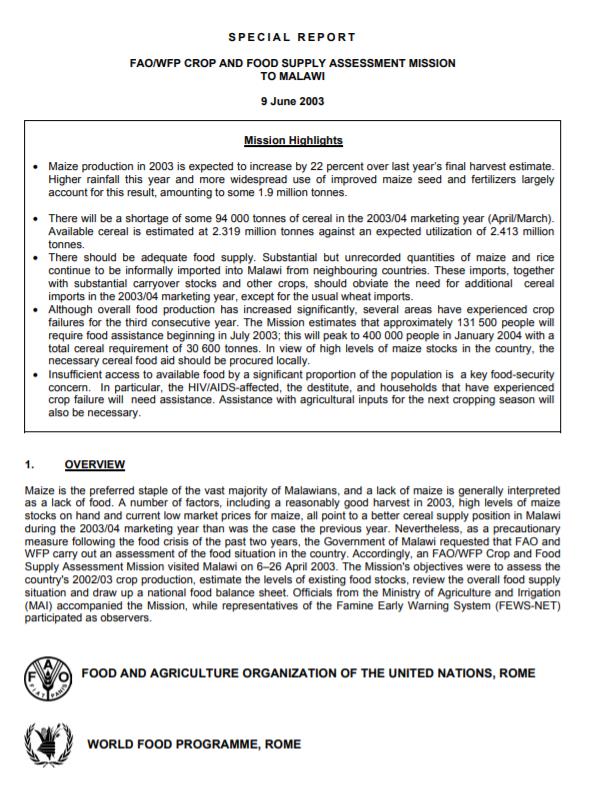
Special Report - FAO/WFP Crop and Food Supply Assessment Mission to Malawi - 9 June 2003
09/06/2003
Maize is the preferred staple of the vast majority of Malawians, and a lack of maize is generally interpreted as a lack of food. A number of factors, including a reasonably good harvest in 2003, high levels of maize stocks on hand and current low market prices for maize, all point to a better cereal supply position in Malawi during the 2003/04 marketing year than was the case the previous year. Nevertheless, as a precautionary measure following the food crisis of the past two years, the Government of Malawi requested that FAO and WFP carry out an assessment of the food situation in the country. Accordingly, an FAO/WFP Crop and Food Supply Assessment Mission visited Malawi on 6–26 April 2003. The Mission's objectives were to assess the country's 2002/03 crop production, estimate the levels of existing food stocks, review the overall food supply situation and draw up a national food balance sheet. Officials from the Ministry of Agriculture and Irrigation (MAI) accompanied the Mission, while representatives of the Famine Early Warning System (FEWS-NET) participated as observers.
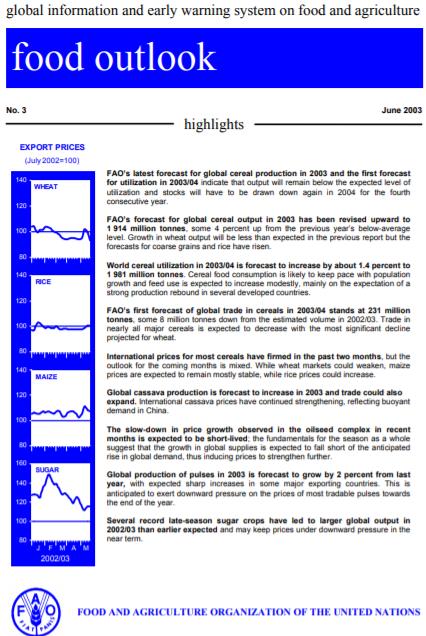
Food Outlook - June 2003
04/06/2003
FAO’s latest forecast for global cereal production in 2003 and the first forecast for utilization in 2003/04 indicate that output will remain below the expected level of utilization and stocks will have to be drawn down again in 2004 for the fourth consecutive year. FAO’s forecast for global cereal output in 2003 has been revised upward to 1 914 million tonnes, some 4 percent up from the previous year’s below-average level. Growth in wheat output will be less than expected in the previous report but the forecasts for coarse grains and rice have risen. World cereal utilization in 2003/04 is forecast to increase by about 1.4 percent to 1 981 million tonnes. Cereal food consumption is likely to keep pace with population growth and feed use is expected to increase modestly, mainly on the expectation of a strong production rebound in several developed countries. FAO’s first forecast of global trade in cereals in 2003/04 stands at 231 million tonnes, some 8 million tonnes down from the estimated volume in 2002/03. Trade in nearly all major cereals is expected to decrease with the most significant decline projected for wheat. International prices for most cereals have firmed in the past two months, but the outlook for the coming months is mixed. While wheat markets could weaken, maize prices are expected to remain mostly stable, while rice prices could increase. Global cassava production is forecast to increase in 2003 and trade could also expand. International cassava prices have continued strengthening, reflecting buoyant demand in China. The slow-down in price growth observed in the oilseed complex in recent months is expected to be short-lived; the fundamentals for the season as a whole suggest that the growth in global supplies is expected to fall short of the anticipated rise in global demand, thus inducing prices to strengthen further. Global production of pulses in 2003 is forecast to grow by 2 percent from last year, with expected sharp increases in some major exporting countries. This is anticipated to exert downward pressure on the prices of most tradable pulses towards the end of the year. Several record late-season sugar crops have led to larger global output in 2002/03 than earlier expected and may keep prices under downward pressure in the near term.
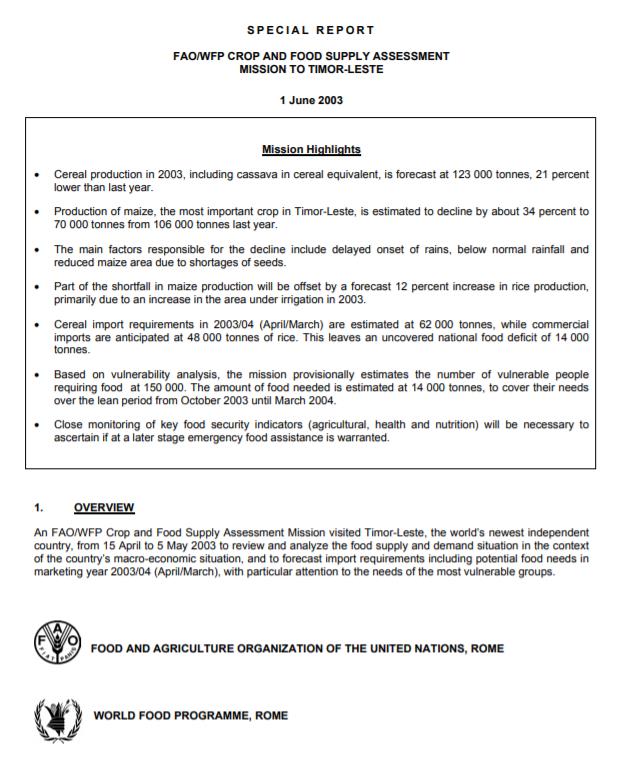
Special Report - FAO/WFP Crop and Food Supply Assessment Mission to Timor-Leste - 1 June 2003
01/06/2003
An FAO/WFP Crop and Food Supply Assessment Mission visited Timor-Leste, the world’s newest independent country, from 15 April to 5 May 2003 to review and analyze the food supply and demand situation in the context of the country’s macro-economic situation, and to forecast import requirements including potential food needs in marketing year 2003/04 (April/March), with particular attention to the needs of the most vulnerable groups.
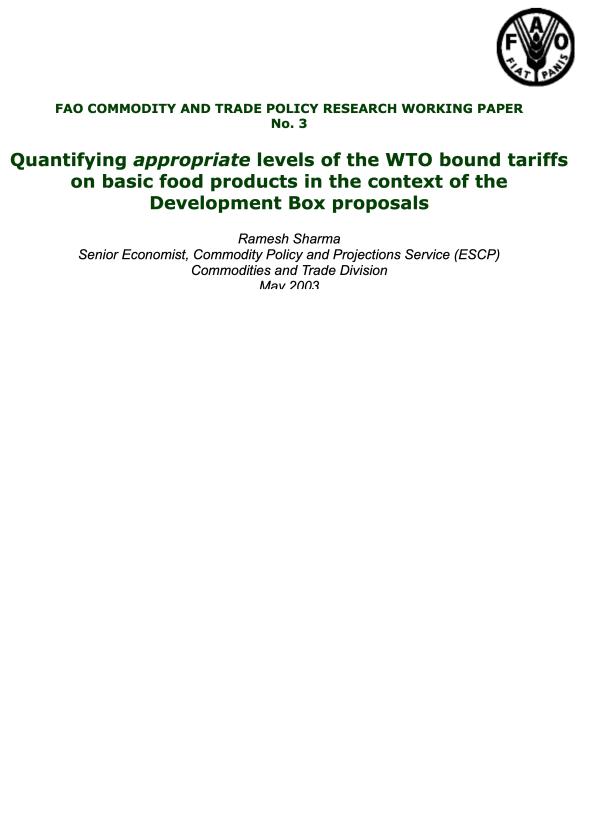
Quantifying appropriate levels of the WTO bound tariffs on basic food products in the context of the Development Box proposals
07/05/2003
Many developing countries in their WTO negotiating proposals on market access have called for the option for them to set appropriate levels of bound tariffs, as special and differential treatment, for selected products vital for food and livelihood security. None of the proposals however is specific on the level of these tariffs, and it is the purpose of this paper to illustrate an approach to quantify them. From a reading of the proposals, including the justifications made, appropriate tariffs are sought not so much for the purpose of protection but to safeguard domestic markets from such external shocks as depressed import prices and/or import surges. Appropriate tariffs, defined as the maximum rates that permit importing countries to raise applied tariffs to fully offset depressed world prices, are computed for 18 basic foods using world price fluctuations of the 1990s as the main basis. The resulting maximum tariffs are in the 40-60 percent range for various foods. This range is not out of line with tariffs actually applied temporarily by several developing countries in recent years when world prices were very low. The computed maximum tariffs do not include protective element for basic foods, which should not be more than 10-15 percent in most lower-income developing countries. Access to simpler safeguards, such as the special safeguard of the Agreement on Agriculture, obviates the need for raising tariffs to the extent computed in the paper. The paper also discusses some issues arising out of this option, which basically amounts to tariff “rationalization” rather than the GATT/WTO tradition of tariff “reduction”.
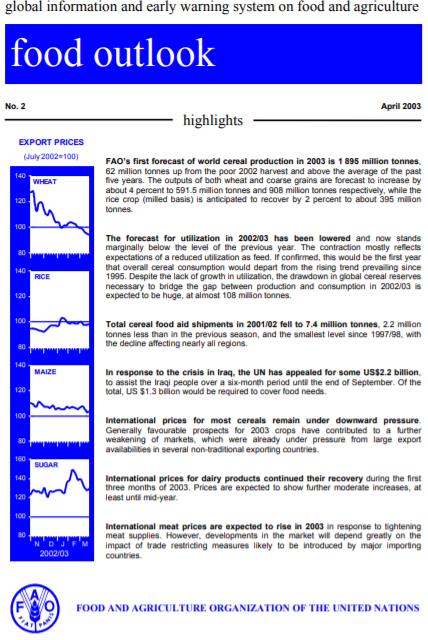
Food Outlook - April 2003
04/04/2003
FAO’s first forecast of world cereal production in 2003 is 1 895 million tonnes, 62 million tonnes up from the poor 2002 harvest and above the average of the past five years. The outputs of both wheat and coarse grains are forecast to increase by about 4 percent to 591.5 million tonnes and 908 million tonnes respectively, while the rice crop (milled basis) is anticipated to recover by 2 percent to about 395 million tonnes. The forecast for utilization in 2002/03 has been lowered and now stands marginally below the level of the previous year. The contraction mostly reflects expectations of a reduced utilization as feed. If confirmed, this would be the first year that overall cereal consumption would depart from the rising trend prevailing since 1995. Despite the lack of growth in utilization, the drawdown in global cereal reserves necessary to bridge the gap between production and consumption in 2002/03 is expected to be huge, at almost 108 million tonnes. Total cereal food aid shipments in 2001/02 fell to 7.4 million tonnes, 2.2 million tonnes less than in the previous season, and the smallest level since 1997/98, with the decline affecting nearly all regions. In response to the crisis in Iraq, the UN has appealed for some US$2.2 billion, to assist the Iraqi people over a six-month period until the end of September. Of the total, US $1.3 billion would be required to cover food needs. International prices for most cereals remain under downward pressure. Generally favourable prospects for 2003 crops have contributed to a further weakening of markets, which were already under pressure from large export availabilities in several non-traditional exporting countries. International prices for dairy products continued their recovery during the first three months of 2003. Prices are expected to show further moderate increases, at least until mid-year. International meat prices are expected to rise in 2003 in response to tightening meat supplies. However, developments in the market will depend greatly on the impact of trade restricting measures likely to be introduced by major importing countries.
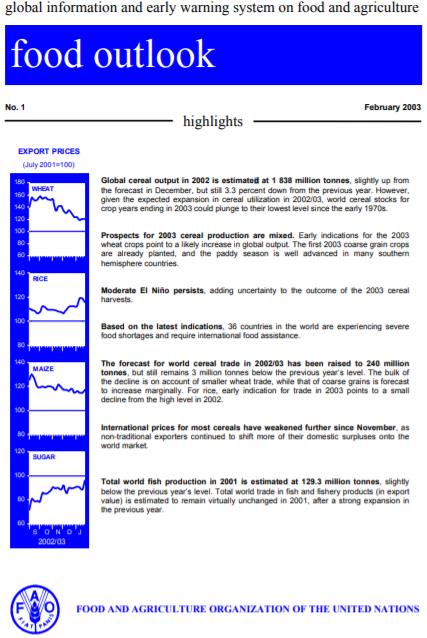
Food Outlook - February 2003
03/02/2003
Global cereal output in 2002 is estimated at 1 838 million tonnes, slightly up from the forecast in December, but still 3.3 percent down from the previous year. However, given the expected expansion in cereal utilization in 2002/03, world cereal stocks for crop years ending in 2003 could plunge to their lowest level since the early 1970s. Prospects for 2003 cereal production are mixed. Early indications for the 2003 wheat crops point to a likely increase in global output. The first 2003 coarse grain crops are already planted, and the paddy season is well advanced in many southern hemisphere countries. Moderate El Niño persists, adding uncertainty to the outcome of the 2003 cereal harvests. Based on the latest indications, 36 countries in the world are experiencing severe food shortages and require international food assistance. The forecast for world cereal trade in 2002/03 has been raised to 240 million tonnes, but still remains 3 million tonnes below the previous year’s level. The bulk of the decline is on account of smaller wheat trade, while that of coarse grains is forecast to increase marginally. For rice, early indication for trade in 2003 points to a small decline from the high level in 2002. International prices for most cereals have weakened further since November, as non-traditional exporters continued to shift more of their domestic surpluses onto the world market. Total world fish production in 2001 is estimated at 129.3 million tonnes, slightly below the previous year’s level. Total world trade in fish and fishery products (in export value) is estimated to remain virtually unchanged in 2001, after a strong expansion in the previous year.
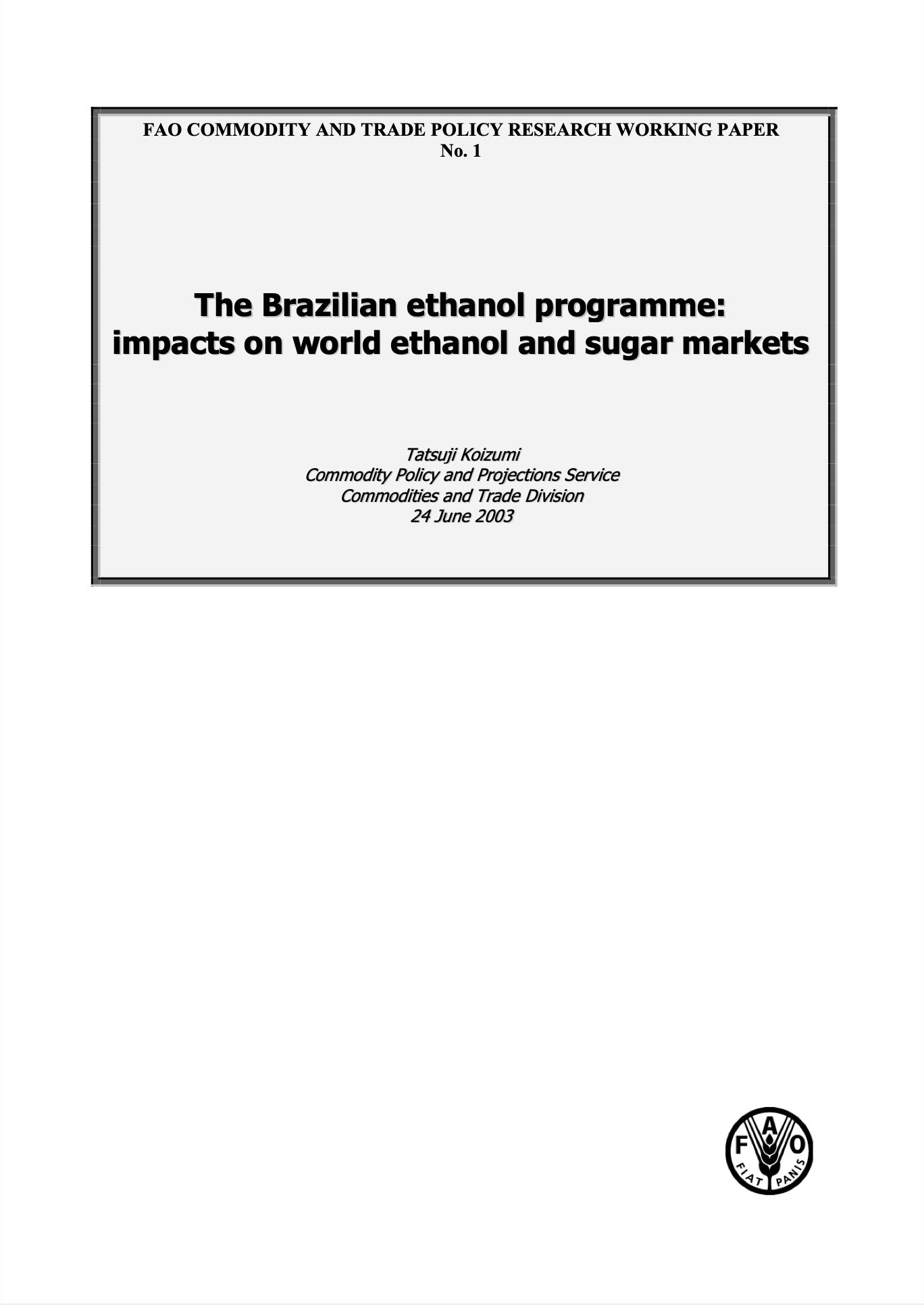
The Brazilian ethanol programme: impacts on world ethanol and sugar markets
01/01/2003
The sugar market in Brazil has a strong relationship with the ethanol market. The Brazilian government has now abolished all the sugar market intervention measures except for the control on the ethanol-gasoline blend ratio. In this study, implications of a change in blend ratio to the sugar markets, particularly in its production resource use is investigated by applying a newly developed Ethanol-sugar market projection model. The model simulation result shows a moderately sized impact on the wor ld ethanol and sugar markets.
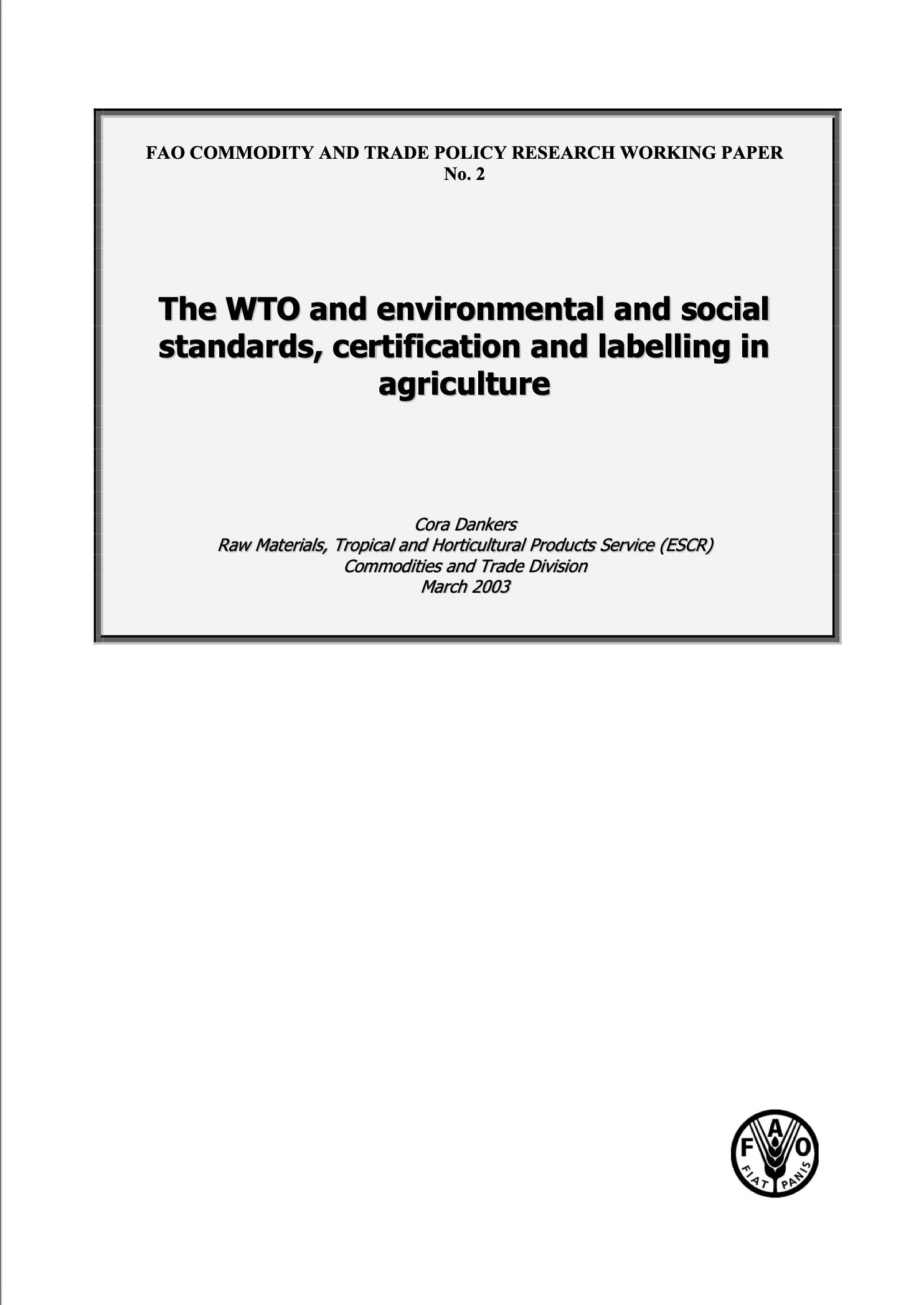
The WTO and environmental and social standards, certification and labelling in agriculture
01/01/2003
This paper reflects on the GATT/WTO legal aspects of social and environmental standards and voluntary certification and labelling programmes in agriculture. The paper focuses on programmes with an international scope and with standards relevant for the crop production sector, including labelling of derived food products. The purpose of the paper is to advise governments and standard setting and labelling organizations alike by presenting the most relevant provisions in the WTO and indicating pos sible implications of these provisions.

